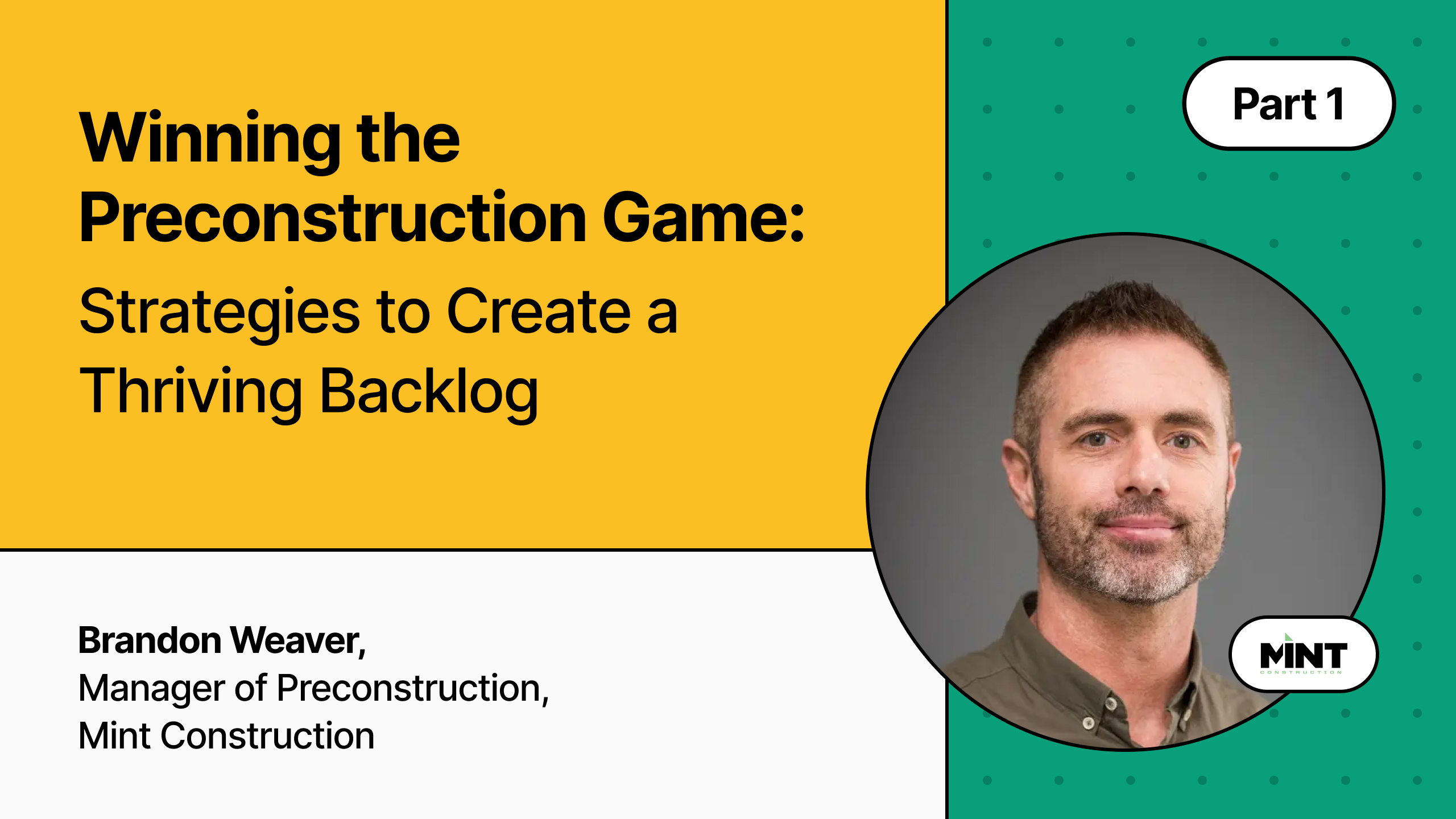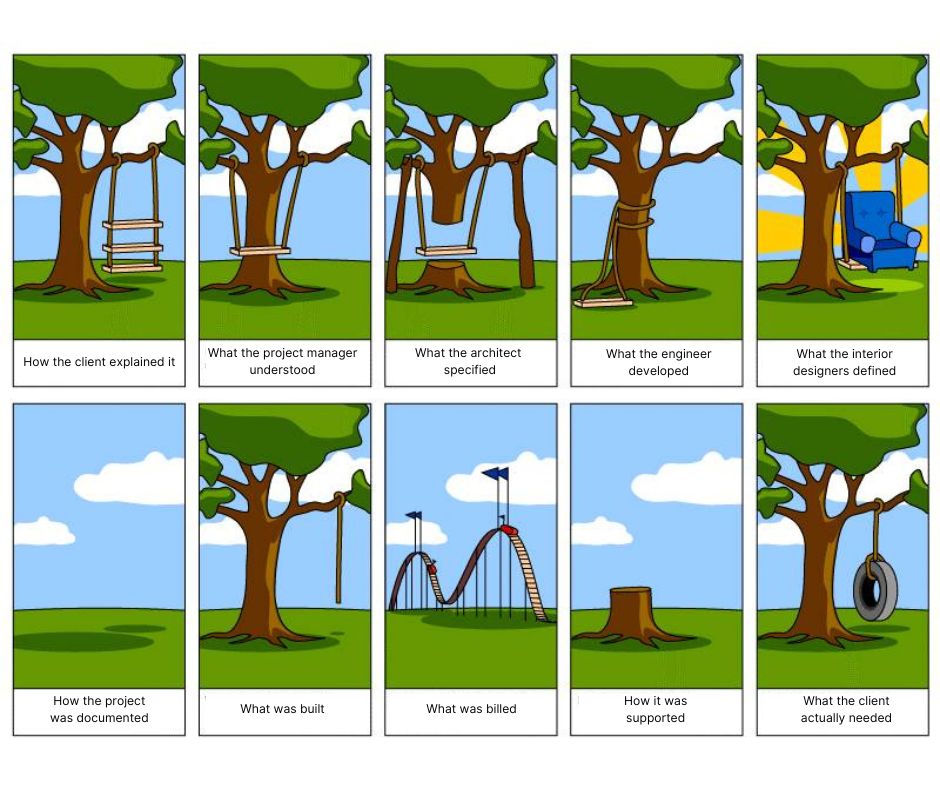
Winning the Preconstruction Game: Strategies to Create a Thriving Backlog - Part 1
Construction is hard. Working on and winning the right jobs will be what keeps general contractors going.
October 10, 2023
10 min read
Learnables

Michael Sullivan
Senior Growth Marketer

Part 1
High performing contractors have one thing in common: a winning preconstruction strategy.
Everything that happens before breaking ground is crucial to running a successful contracting business—from business development, estimating, marketing, workforce planning, and construction handoff. Brandon Weaver and his team at Mint Construction knew that to become a high-performing general contractor in the modern era, they had to revolutionize their preconstruction process. And that’s exactly what they did.
At Procore's annual Groundbreak conference which took place in Chicago this year, Brandon hosted an hour-long breakout session where he shared the strategies he used at Mint Construction that led to becoming a high-performing contractor. This blog is the first part of a series adapted from that talk, and is an overview of how he was able to take Mint from a brand new general contractor to one of the best in the industry in less than 5 years by dialing in on preconstruction.
Brandon has been with Mint Construction since 2018, bringing years of experience in starting and developing companies. He oversees business development/strategy, culture experience, as well as development of internal processes and efficiencies. Mint has grown from a start-up company in 2016 to well into the nine figures in just over five years.
Level set client expectation
Brandon and his team at Mint primarily do design-build construction, finding upwards of 80% of their revenue coming from the design-build route while the other 20% comes from a hard bid/competitive situation.
The hard bid world, Brandon believes, is The Office-level comical that's rife with very obvious inefficiency and miscommunication.
The fact that four to five hundreds bids come in, you're expected to sift through all of them, pick and assign each trade that has a complete scope of the project, give the client an accurate estimate, and promise not to go over that number—it's simply an insane proposition. Change orders are inevitable. Yet this situation is the norm in the hard bid world.
Brandon thinks the following image perfectly illustrates the type of miscommunication that runs rampant in the world of construction:

There's a saying that goes, "People will only do as good as they know how." In construction, this translates to "Owners will treat GCs as well as they know how" and "GCs will build the project as well as they know how."
One of Mint Construction's core principles is that they use the preconstruction process to help make the client "know how" to work with them. They will level set with their client before the job to get expectations right. They will even share and explain the tree swing image to remind them that there's so many moving pieces in construction and it's easy for things to get lost in translation.
When communication between GC and client is strengthened, it naturally strengthens the bond that would better lead to repeat work. Repeat work, as our blog always impresses, is the lifeblood of general contractors, and should be the number one priority for high-performing general contractors to reverse-engineer, a process that begins at the preconstruction stage.
Be aware of interest rate effects
Interest rates and slowing projects aren't yet problems approaching a nationwide epidemic, but they're hinted at by industry experts (or, more colloquially known as "soothsayers") that believe the lag will eventually catch up. Some markets have slowed, others haven't—we're still in bend, not break mode.
As a preventative "getting a lay of the land" measure, Brandon prioritizes staying in touch with many general contractors across different states that build in market segments that Mint builds in to see what those other builders are seeing and hearing. This year, he's heard:
Some jobs aren't starting when they're supposed to,
Hundreds of millions of dollars in multifamily projects that are on hold,
Developers saying it'll be a year to eighteen months before projects get off the ground,
Projects are struggling with financing in the middle of building,
GCs in the higher ACV range having a ton of their people sitting on the sidelines.
Having a strong backlog is important, though preparing for unexpected stalls is always important in an industry with so many moving pieces and costly manpower that's exponentially more costly when they're hanging out on the bench because project starts get pushed.
Fight the temptation to bid low
Start dates not happening when they're anticipated costs builders money. So does competition. For general contractors, competition in the market drives costs down, especially labor costs.
It may be tempting to bid significantly lower than you'd normally be comfortable with, especially if you're a newer builder trying to establish new relationships and pull clients away from your competition that may have repeat work with certain owners. The main issue with this mindset is that too big a money gap between the change orders could spell trouble on a few different fronts. A worst case scenario, of course, is that you never work with a certain owner again.
Another worst case scenario is that a certain bank never lends to you again. A major issue with "wishful thinking" bids is that banks are getting tighter with whom they lend out money to. If a GC is denied by a bank, it's conceivable that the GC will never be approved by that bank again. The tighter-wallet banks have higher odds to sniff out a too-low bid as being B.S. They foresee a builder asking for more money later, thus it's smarter for them to say no upfront.
For the longterm health of your company, Brandon urges, be mindful in your bidding. "Sometimes the best job is the one you didn't get."
Treat subcontractors like your employees (and customers)
Bid fatigue, Brandon explains, is a huge issue for his team at Mint Construction. Bid fatigue can occur when the same job is bid on multiple times.
Mint has a mantra that a superintendent came up with: "Treat your subcontractor like they're an employee at Mint." Construction is a unique industry because there's no parallel to the complex role of the subcontractor. When you really dig deep and look at it, subs are like employees and customers because of two truths. Subcontractors:
Do work for you for a paycheck on a schedule, and
Occasionally do rework for you on the same project.
Bid fatigue can be a preconstruction issue for builders because it could harm the relationship between contractor and subcontractor. Thus, a rule at Mint is that they tell developers not to put a project out to bid until they're within 2 months of actually starting the job and financing is in place. Sending a project out to bid 6-8 months before it's ready is a proactive measure for developers to get budgets that are more accurate. The thing is, any good general contractor will get the owner an accurate budget, regardless.
Stay in the loop
Seriously, you should sign up to be a construction insider. Everyone will be so jealous of you.